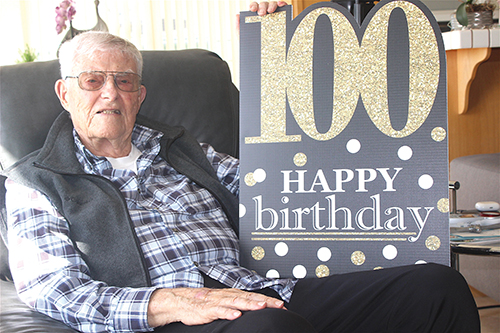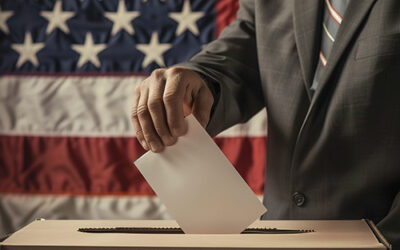Morro Bay resident Herb Berry, who was a Navy fighter pilot in two wars, recently celebrated his 100th birthday.
Anyone who lives to 100 has undoubtedly had an eventful life seeing the world change over a lifespan that few will reach, and experiencing first hand things one reads about in history books.
For Morro Bay resident, Herb Berry, who turned 100 in January, that journey took him all over the world, into two major wars, through the growth of air travel, and the birth of the journey off the planet and into space.
Herb says he was born in Turlock, Calif., but didn’t spend a lot of time in that Central Valley farming community.
“We moved from Turlock when I was 10-months old,” Herb says while sitting in a comfy recliner in his living room with a sweeping view of Estero Bay through sliding glass doors. “I mostly lived in Chico.”
That was because of Chico State University, where he began his university studies as a history and English major. He had a brother and three sisters, he explains.
He joined the Navy in the 1940s with war raging in Europe and the Pacific leaving Chico State behind. “My first active duty was at Cal Poly,” he says. He spent 12 weeks here with the 4th Battalion 1st Platoon. “I’m a Cal Poly alumnus.” He attended Naval Aviation Prep School and his eyes were set on the skies, destined to become a Navy flyboy.
He attended war service training to become a pilot and got his primary training in Kansas, where he learned to fly in freezing temps in a plane with an open cockpit. He finally graduated flight training while in Pensacola, Fla., in September 1944.
He was sent to the Pacific to fly Corsair fighter planes and ended up on the aircraft carrier, Intrepid, after it had been repaired and returned to duty from a Japanese kamikaze attack.
Herb says his was a replacement unit that spelled pilots on Intrepid when needed. “I made exactly one landing on Intrepid,” he says.
They were sent to Saipan to fly cover for B-29 bombers that were the main bomber aircraft used in the Pacific Theater. He was in the air when the Enola Gay, the bomber that dropped the A-bomb on Hiroshima, made its fateful mission.
“They told us not to fly near it,” he explains giving the bird at least seven miles clearance. “We didn’t know when the bomb was going to be dropped.”
After the world’s first atomic bomb exploded, they were placed on high alert, anticipating a Japanese counter attack. “A very feeble attempt was made,” he recalls. “Then we dropped the second bomb and the rest is history.”
During WWII Herb says he was stationed on various islands and fought in the battle for Guam. U.S. forces island hopped and built an airstrip on the Isle of Tinian where the Enola Gay launched from. He was at Saipan, an island away from the Japanese island of Iwo Jima. And once Iwo was taken, the B-29s moved there, he says. That was the most traumatic point of his service, which extended past WWII.
“I stayed in the Navy,” he says, “it was too late to enroll in college again.”
He spent some time with the Naval Air Transport Command and flew POWs home from Guadalcanal.
Herb smiles and says he “was one of the few who got paid for riding a burro.”
After the war he and a friend became test pilots and were on a routine flight from Alameda to Jacksonville, when tragedy nearly struck.
In an article written by his fellow pilot, Donald M. Day, the details of that Dec. 9, 1945 flight were recounted. Day writes that the first leg of their journey from San Francisco to Loa Angeles went smoothly.
Weather delayed their departure from San Pedro but they took off around 2 p.m. when the skies cleared. This leg from California to Tucson, Ariz., was familiar to the flyers, so again they didn’t consult a map.
Two hours out of San Pedro, though, Herb’s plane developed problems and “began to shake with a rough-running engine.”
Day’s article recounts that Herb, “couldn’t use more than 1600 rpms.” Bad weather over Phoenix forced a course change, in hopes they could fly around it.
Then Herb’s radio went out in the Grumman Hellcat airplane and he couldn’t transmit or receive. Then 10 minutes out of Tucson, Day’s radio died too. The airstrip lights couldn’t be seen from their position and Day writes that he decided to fly back to Phoenix, “by dead reckoning and hope we could find a field.”
But that storm they’d avoided was waiting over Phoenix. Day’s account says they set a compass for what he thought was San Diego and the West Coast, with no radios, and fuel becoming an issue.
When he spotted the ocean, Day estimates they were about 160 miles south of the border. They had flown over Baja California at 5,000 feet, flying through a valley with mountains that rose to over 10,000 feet.
With just 25 gallons of fuel left, the two turned north to follow the coastline back to San Diego, but ran into thick fog.
Soon, with just 15-gallons of fuel left, Day reports a “feeling of despair overwhelmed me.” He signaled Herb to prepare for a night landing on the water. They finally spotted lights, but they were not city lights but bonfires burning on the beach. But there was a problem.
“To land on the beach,” Day writes, “in a strange land would be flirting with death, and I wasn’t going to kill my wingman or myself just after completing the most terrifying flight of our careers.”
Herb and Day planned to land offshore but there was another problem that he’d just realized — neither man had a “Mae West” inflatable life preserver.
Herb landed his plane about 1,000 feet from shore, Day recounts, “and got out without a scratch. Three minutes later, I landed with the fuel gauge reading 6 gallons; hit hard and rode far up onto the nose.”
Day’s plane slowly began to sink nose first. But he clambered out and swam about 300 feet to shore and walked down the beach to one of the bonfires, which had several frightened Mexican clam diggers huddled around it.
A search party was organized to look for Herb, but he soon “staggered up, clad only in his shorts and practically freezing to death.” The two pilots embraced with relief that they’d both made it.
“It was the first time I had spoken to him in three hours,” Day’s account says. “We had gone through hell together without being able to say a word.”
That’s when Herb got paid to ride a burro, as the two pilots rode through some of North America’s most rugged country to a Mexican Air Force auxiliary airfield where they radioed their base. They hopped a Mexican Air Force plane to Ensenada and then a Coast Guard plane to Lindbergh Field in San Diego, their ordeal becoming a harrowing tale to tell.
Day reports they later discovered why they had so much trouble. First they had the wrong maps and the two planes and previously had radio and engine troubles. “Ensign Berry and I had taken off in planes that had not been okayed for the trip.”
Herb chuckles that this story “Wasn’t a war story; it was a stupidity story.”
Herb became a “weekend warrior” in the Navy Reserves after WWII until the Korean War. He was with the Oakland Air Group which he says had a 70% casualty rate in Korea, while “Flying the same planes I flew in World War Two.”
He made training films while stationed in Anacostia and flew F-8 jet fighters at the time. He made his last carrier landing in a jet plane and then, “I felt I’d had enough of that.”
He moved into the aerospace industry to help train astronauts, he says. They worked in zero-G pools to boost buoyancy and checked for leaks with the Saturn 5 rockets in a Top Secret program that President Nixon eventually nixed.
“The people we were training,” Herb recalls, “were the first to fly the Space Shuttle.” The crew on that April 1981 flight aboard the Columbia was Cmdr. John Young and Pilot and pioneering astronaut, Robert Crippen.
Bobby Crippen, Herb says, was related to a friend of his family and he thought the name was familiar when they first met.
He met the woman who would become his second wife back in Chico at a Christmas dance in 1944. But Herb says he already had orders to go over seas. “The next time I met her,” he says, “she was engaged to a friend of mine in Chico.”
He met Dorothy, the woman he would marry, by accident. “I sat on her glasses,” he laughs. “So I decided I should marry her.” He and Dorothy had a long happy life together, staying married for 62 years, until she died. They had two daughters one of whom, Deborah, is still alive today and he has three grandkids and a great-grandchild.
After Dorothy’s death, he says he renewed his friendship with the earlier apple of his eye, Elizabeth Jean, and the two lived together for 9 years. They eventually married, but Elizabeth died just a week later.
“I was very, very fortunate,” Herb says, “both of my wives were tremendous and supportive. I don’t think I could have done better.”
He and Dorothy settled in Corona Del Mar in Orange County in 1952, and he recalls how across the street from them was a big park that hosted the Boy Scout Jamboree. His dog used to chase deer in the vacant field across the street, which eventually became a shopping center.
They were in Buffalo Ranch, he explains which became U.C. Irvine. Corona Del Mar had a population of about 600 when they first moved there and now has over 100,000.
He worked a full career for McDonald Douglas certifying its MD-11 passenger plane. And eventually retired but it didn’t last.
In 1993, he says, he became a consultant for the government of Indonesia, which was trying to design an airplane, the N-250. He was among a group of ex-pats from the U.S. working on that project. They had to hide anytime (President Bill) Clinton and (British Prime Minister Margaret) Thatcher came to visit because the Indonesian government “didn’t want to admit they weren’t designing this airplane.”
He said they had a wonderful experience living in Guangdong and his wife Dorothy was involved in a clinic that repaired cleft pallets. “They had a DC-10 retrofitted to perform surgeries,” he says. “People would line up for blocks” to await the surgeries. “I still contribute to the program.”
He says he learned humility realizing how people in Third World and Second World countries live.
As for the Indonesian airplane, “I realized that the plane was never going to be operational.” He adds that the World Bank invested billions on an airplane that “flew 70 meters all together and never flew again.”
He had seven people working for him who were terrified of flying. He used to sit them in the cockpit and rev the engines.
He retired for a second time and he and second wife Jean, moved up to Morro Bay in 1998.
They did a lot of traveling all over the world. Meeting Jean’s grandson while on a trip to Chile. “We went through the Panama Canal five times in one year,” he recalls. Most of their trips started in Florida.
“I’ve had a full and wonderful life,” he says, as his current companion, a cute little dog named Eugene, which he adopted from Woods Humane Society, comes to say “Hello” to a reporter.
He enjoys his friends and neighbors including a group calling itself “Berwick Babes,” who check in on him and who on Jan. 22 threw him a block party for his 100th birthday. He also got a letter from President Joe Biden congratulating him on the milestone and thanking him for his service in the Navy. “It was a wonderful gesture,” he says of getting the letter on White House stationary.
So what’s been the best thing about his long life? “I’ve been asked that question and one thing I have to say is I have good health — my eyesight is still good but I’m just not as mobile as I used to be.”
He gets help from Monarch Home Care, who he says have been wonderful. Why’d they pick Morro Bay to live?
“One reason we came to Morro Bay,” he says, is there were 10,200 people and now in 2023, there’s about 10,400. It’ll never be a big city, which I think is wonderful.
“The people here are unique in that there are no strangers. They’re outgoing.”
He praises his neighbors. “The support group I have that live here,” he says, “are all unbelievable.”




